-

人教版新目标初中英语八年级上册Can you come to my party教案3篇
Step 3 (3b)First, tell the students when we talk about our future plans, we often use: I’m+verb+ing When we talk about what we must do, we use have to. Ask the students to fill in the blanks in 3b. The answers are: shopping, go to see, a test, I’m going, my family. Step 4 (3c)Let the students write an e-mail message to a friend. Say why you can’t visit next. Before the exercise, ask the students to give some possible answers and write them on the blackboard. So the students will feel easy to finish the writing exercise. After they finish it, Let them to correct it in groups first. Each group chooses theirs best one to read in front of the whole class. Step 5 ( planning a party )First read the conversation in the box together. Then ask the students to turn to page 88.Write down everything you have to do next week. Write in all the things you have to do . Ask the students to look at the list. Ask them “What day are you free?” This is when you can have your party. Step 6 (Self check 1 )Let the students to fill in the blanks with the words given. Change the forms of the words if possible. Then make their own sentences. The answers are: visit, playing, have to, study, comeStep 7 (Self check 2)Imagine you are Marie. Read the information and look at your schedule. Write replies to the invitation.

人教版新目标初中英语八年级上册How was your school trip教案2篇
“Go for it!” is based on “Task-Based Language Teaching”. It adheres to “The authenticity principle”, “The form-function principle”, “The task dependency principle” and “The principle of learning by doing”. These principles all accord with the demands of curriculum focus.In and of Grade Seven (II), “Go for it!”, students have learned “The Simple Past Tense”. And it appears again in of Grade Eight (I). teaches students more about how to talk about events in the past. In addition, it gives affirmative and negative statements in the past tense, such as the sentence patterns “Did you see …?” “Were there …?” “Did you go …?” As the first part of Unit 8, Section A opens with a picture presenting the last school trip in the aquarium and continues with several step-by-step practice activities, which are all good for students to master “The Simple Past Tense”. Doing well in Section A will help students integrate the new target language with that in Section B. Thus, they can describe the events in the past freely and foster their own ability of reflecting and practicing. II. Teaching ObjectivesTeaching objective is the beginning and aim of teaching activities. According to the overall goal of the English elementary course--- improve students' synthetic ability of language application, which should be based on the development of students’ “Language knowledge”, “Language skills”, “Character building”, “Learning strategies” and “Cross-cultural awareness”. The teaching objectives are described as follows(I). Knowledge objectivesi. Master the simple past tense of regular and irregular verbsii. Recite the new words and expressions about the last school trip in the aquarium, including their pronunciation and intonation

人教版新目标初中英语八年级上册Could you please clean your room教案3篇
一、 教学内容Section A 1a----1c二、 教学目标1.学习词汇do the dishes, make the bed, take out the trash, fold the clothes, do the laundry, sweep the floor, clean the living room.2.句型 Could you please clean your room? Yes, sure.三、 教学准备 学生预习本单元所有的词汇多媒体课件 活动表 奖品四、 教学过程Pre-task1. Warming upEnjoy ourselves. Watch cartoon Cinderella. 看动画片段《灰姑娘》导如入本课话题和新词汇“chores”美丽善良的鬼姑娘因继母的嫉妒,每天得做所有的家务。片段的主题使学生联想到本课的话题。2. learn new words and phrasesLook! What is she / he dong? 看图学习动词词组do chores, do the dishes, make the bed, take out the trash, fold the clothes, do the laundry, clean the living room.3. Guessing game.What is she doing ? 4. Pair work. 1a, Do you do these things at home? Write “Y” for “yes” and “N” for “no”.5. Listening . 1b , Peter’s chores or Mom’s chores?理解目标语Could you please clean your room? Yes, sure.Write “M” for Mom’s chores, “P” for Peter’s chores in the chart.6. PairworkLook at the picture,Ask your partner to do the chores that you see. 7. Interview Who is the most able at home? 1) What chores do you do at home? How often do you do the chores? Work in four, interview each of the students in the group, fill in the chart.

人教版新目标初中英语八年级上册How do you get to school教案2篇
Step Ⅶ Role play ( Work on 1b)1. First ask two students to read the dialogue to the class.Sa: How do you get to school?Sb: Well, I ride my bike to the subway station. Then I take the subway.2. Now work with a partner.Suppose you use two kinds of transportation to get to school \Hangzhou\Beijing... (bus, train, subway, walking, bike, etc.) Tell how you get there. You may use the phrases in 1a.3. Then ask different pairs of students to present their conversations to the class.Step ⅧListening1. Work on 2a(1) First ask students to read the list of information that Thomas wants to know.…where Nina lives.…how far from school she lives.…how long it takes to get to school.…how she gets to school.…what she thinks of the transportation.(2) Tell students what transportation and bus stop mean.bus stop 汽车站 transportation n. 运送;运输Then tell students we'll hear a recording. Please put a checkmark in front of each thing that Thomas wants to know.(3) Now play the recording for students.( Have students pay attention to the sample answer.) (4) Then correct the answers.

人教版新目标初中英语八年级上册I’m going to be a basketball player教案3篇
教学目标1.知识目标:(1)学习What are you going to be when you grow up?/How are you going to do that?句式。(2)学会用英语描述有关职业的表达法。2.能力目标:(1)能够谈论为实现理想所做出的打算和安排。(2)能够谈论未来自己与他人理想的职业及原因。(3)能用英语描述课余时间的活动安排,最终具备表达综合信息的能力。3.情感目标:新学期到来之际,让他们在学习、体育、饮食、特长、读书等方面制定计划,教育学生合理安排自己的课外生活,思考自己的理想职业及适合自己的职业。教学重点、难点本单元的重点为“be going to”表将来,want to be, what,where, when,how引导的特殊疑问句。难点是语言目标的实现。教材分析本单元以I am going to be a basketball player为话题,共设计了三部分的内容:一、Section A该部分有4个模块。第一模块围绕Do you think these jobs are interesting?这一话题展开思维(1a)、听力(1b)、口语(1c)训练;

人教版新目标初中英语八年级上册What’s the matter教案2篇
She shouldn’t go to the party tonight.Step7. TaskT: You know, there are lots of problems in our life. If you are a doctor, please tell us how to solve the problem. I will divide you into 9 groups. Please work in groups. And then choose one of you to report your ideas.The following are the problems:I have a toothache.I am hungry. I have a sore throat.I am stressed out. I have a sore back.I am tired. I can’t sleep.I have a cold. I have a headache.Report: If you have a headache, you should go to bed early. You should see the doctor. You should eat some medicine. You shouldn’t wash your face with cold water.You shouldn’t sleep late.You shouldn’t swim.…..T encourages the students to give advice as much as possible.Homework:1. Chose one of the problems, and write down your advice2. Copy the new words这一步是用于热身的,同时也可以让他们复习一部分的表示人体部位的单词,扩充知识.学习语言的过程也是一个不断积累的过程,复习旧知识,增添新知识.通过小游戏,强化学生对Does she/he have…这个句子的运用能力.通过复习,自然的引到下面新知识的学习。充分利用表格,由句子到对话,再到文章,让学生循序渐进. 提高学生的综合语言运用能力,运用以前学过的知识来解决身边的问题.Period 5 (Section B 3a—3c, selfcheck)教学内容与分析:

人教版新目标初中英语九年级上册Teenagers should be allowed to choose their own clothes教案2篇
Step 1 Greeting Greet the class and check the homeworkStep 2 A duty report The S on duty gives a report on the rules in his home and lead in 3a “Sun Fei’s and Wu Yu’s rules” Step 3 ReadingSs read the conversation and write the two girls’ rules in the chart. Check the answers.Get Ss to read after the tape and then read aloud by themselves. Then, T explains the language points.Step 4 Pairwork 3bRole play. Use the information in chart to practice with the conversation in 3a covered. They can look at the sample conversation in the right box.Step 5 Task 2 “Who’s the best reporter?”Make a survey by asking any 5 students the questions in the chart in activity 4. Then give out a report about it. See who is the best reporter? And the best reporter will get a nice ball-pen.Step 6 Summary and homework:Write out the report in your exercise-books.Period ThreeStep 1 Greeting and a duty reportThe S gives a duty report talking about his experience of being late for school. Lead in the question “Do you ever get to school late? How often do you get to school late? Always, usually, sometimes, or never?Step 2 1a Get Ss to finish writing.Step 3 Pairwork 1b Get Ss to talk about their answers with their partners using the sample conversation in the box on the right.Step 4 Listening practice2a Lead-in: What will happen if you get to school late? What about Peter? Let’s listen to a conversation between Peter and his father. Get Ss to finish 2a (As usual, for the first time, Ss only listen.) Check the answers.

人教版新目标初中英语九年级上册I like music that I can dance to教案
教学目标: 1. Express preferences2. Talk about one’s likes and dislikes and the reasons3. Learn to express one’s opinions 4. Learn to write a reply 语言功能: 1) Talk about one’s preferences, using t he relative clause2) Talk about people’s likes and dislikes and the reasons3) Talk about opinions语言结构: Relative clauses with that and who语言目标:What kind of music do you like?I like music that I can sing along with.I love singers who write their own music.We prefer music that has great lyric.重点词汇及短语:heart, photography, interest, class, whatever, miss, okay, expect, sweet, taste, itself, laboratory, cancer, increase, biscuit, main, care, prefer… to…, remind somebody of …, dance to, sing along with, be sure to, interest somebody, make somebody adj., to be honest, suit somebody, on display, catch up教学重难点:What do other people think of the different kinds of things? How to express one’s opinions? 学习方式:讨论,合作学习情感目标:通过本单元的学习,能提高学生的艺术鉴赏能力和审美情趣,并引导学生养成健康的饮食习惯。课时安排5课时第一课时:Section A: 1a-2c第二课时:Section A : 3a-4第三课时:Section B:1-2c, Self check2第四课时:Section B: 3a-4, Self check1第五课时:Self check ReadingI like music that I can dance to.

人教版新目标初中英语九年级上册It must belong to Carla教案
一、Section A该部分有4个模块。第一模块围绕Whose volleyball is this? 这一话题展开思维( 1a)、听力(1b)、口语( 1c)训练;第二模块围绕上一模块中的话题进行听力( 2a-2b)、口语训练( 2c);第三模块继续围绕前两个模块中的“making inferences”展开训练。训练形式为阅读排序( 3a)和两人问答(3b);第四模块仍就上一话题展开讨论。二、Section B该部分有4个模块。第一模块要求根据图画和所提供的单词写出合理的句子;第二模块在听力( 2a-2b)和分角色口语训练( 2c)的基础上,继续进行“推测”训练; 第三模块围绕“Strange events in Bell Tower neighborhood”这一话题展开阅读( 3a)和写作(3b -3c)训练;第四模块以dream为话题展开小组活动。三、Self Check该部分有3个模块。第一模块以填空形式对所学词汇进行训练;第二模块就8个谚语展开阅读和讨论。

人教版新目标初中英语九年级上册Where would you like to visit教案2篇
The First PeriodⅠ.Teaching Aims and DemandsKnowledge Objects(1) Key Vocabularytiring, educational, fascinating, thrilling, peaceful, exotic, trek, jungle, take it easy, explore, historic, site(2) Target LanguageWhere would you like to go on vacation?I’d like to trek through the jungle, because I like exciting vacations.2. Ability Objects(1)Train students to talk about places they would like to visit with the target language.(2)Train students to describe vacations with different adjectives.(3)Train students' listening skill.3. Moral Object,It′s more interesting to go on vacating somewhere instead of staying at home.Ⅱ. Teaching Key Points1. Key Vocabularytiring, educational, fascinating, thrilling, peaceful, exotic, trek, jungle, take it easy, explore, historic, site2. Target LanguageTalk about different places with the target language.Ⅲ. Teaching Difficult Points1. Describe vacations with different adjectives.2. Talk about different places with the target language.Ⅳ. Teaching Methods1. Teaching by illumination2. Teaching by doing chain drills3. Teaching by pairworkⅤ. Teaching Aids1. A tape recorder2. Some pictures of different places with famous views

部编版语文八年级上册《名著导读:红星照耀中国》教案
读序言,可以了解内容概要、写作缘由和过程,明确写书的纲领和目的。学生活动一:用5分钟时间浏览一篇序言(译者序和作者序任挑一篇),运用跳读法采集信息点,记录在便利贴上。并互动交流。小结:序言告知我们,“红星照耀中国”是作者在中国及世界局势即将发生大转变的关键一年,冒险来到西北红色区域采访后得出的结论。那么他在苏区见到了什么,听到了什么呢?让我们把视线焦点集中到他笔下那一群“不可征服”的革命青年身上。(二)读目录,了解主要内容及写作顺序1.学生浏览目录,说一说,这本书的写作顺序是怎么样的?主要写了哪几方面的内容?【方法指导】读目录,可以对作品的内容要点和篇章结构有所了解,迅速查阅到所需要的部分。明确:《红星照耀中国》是一部文笔优美的纪实性很强的报道性作品。作者按照事件发生的自然时间顺序真实记录了自1936年6月至10月在我国西北革命根据地进行实地采访的所见所闻。该书绝大部分素材来自作者采访的第一手资料,向全世界真实报道了中国和中国工农红军以及许多红军领袖、红军将领的情况。

部编版语文九年级上册《中国人失掉自信力了吗》教案
一、导入新课我们已经学过鲁迅先生的不少文章,学过他的小说,看他用无数生动的形象表达他在时代里的“呐喊”与“彷徨”;学过他的散文,与他一同在失落中“朝花夕拾”,安静地回忆过往。今天,我们将学习鲁迅先生的一篇杂文,看他是如何作为民族斗士,将手中的笔,变成抨击敌人的枪。二、教学新课目标导学一:学习驳论,理清思路1.初读课文,找出对方的错误观点,并说说作者是怎样引出这一观点的。明确:对方的错误观点是“中国人失掉自信力了”。开篇以似乎确凿的事实为据,用一句话指出了三个阶段中“中国人”表现出来的三种不同的态度:盲目骄傲,夜郎自大;盲目崇拜,借助外援;今不如昔,祈求鬼神。即由自夸到崇洋,到自欺欺人、虚无渺茫的态度变化。因此有人“慨叹”:“中国人失掉自信力了。”这是论敌的论点。
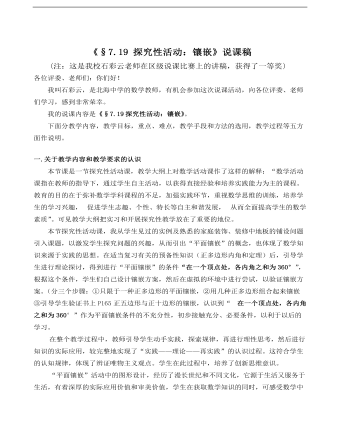
初中数学人教版八年级上册《719镶嵌》说课稿
一.关于教学内容和教学要求的认识 本节课是一节探究性活动课,教学大纲上对数学活动课作了这样的解释:“数学活动课指在教师的指导下,通过学生自主活动,以获得直接经验和培养实践能力为主的课程。教育的目的在于弥补数学学科课程的不足,加强实践环节,重视数学思维的训练,培养学生的学习兴趣,促进学生志趣、个性、特长等自主和谐发展, 从而全面提高学生的数学素质”。可见教学大纲把实习和开展探究性教学放在了重要的地位。
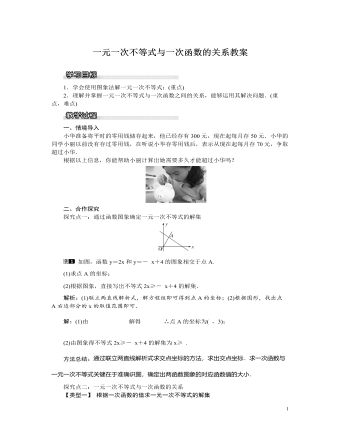
北师大初中八年级数学下册一元一次不等式与一次函数的关系教案
解析:先利用正比例函数解析式确定A点坐标,然后观察函数图象得到,当1<x<2时,直线y=2x都在直线y=kx+b的上方,于是可得到不等式0<kx+b<2x的解集.把A(x,2)代入y=2x得2x=2,解得x=1,则A点坐标为(1,2),∴当x>1时,2x>kx+b.∵函数y=kx+b(k≠0)的图象经过点B(2,0),即不等式0<kx+b<2x的解集为1<x<2.故选C.方法总结:本题考查了一次函数与一元一次不等式的关系:从函数的角度看,就是寻求使一次函数y=ax+b的值大于(或小于)0的自变量x的取值范围;从函数图象的角度看,就是确定直线y=kx+b在y轴上(或下)方部分所有的点的横坐标所构成的集合.三、板书设计1.通过函数图象确定一元一次不等式的解集2.一元一次不等式与一次函数的关系本课时主要是掌握运用一次函数的图象解一元一次不等式,在教学过程中采用讲练结合的方法,让学生充分参与到教学活动中,主动、自主的学习.
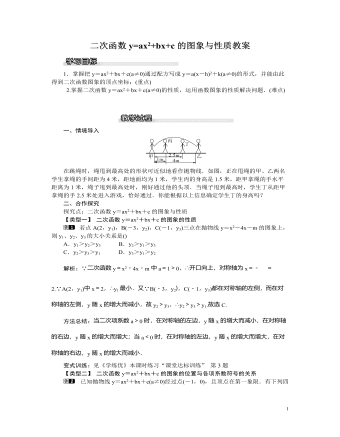
北师大初中九年级数学下册二次函数y=ax2+bx+c的图象与性质1教案
解析:(1)已知抛物线解析式y=ax2+bx+0.9,选定抛物线上两点E(1,1.4),B(6,0.9),把坐标代入解析式即可得出a、b的值,继而得出抛物线解析式;(2)求出y=1.575时,对应的x的两个值,从而可确定t的取值范围.解:(1)由题意得点E的坐标为(1,1.4),点B的坐标为(6,0.9),代入y=ax2+bx+0.9,得a+b+0.9=1.4,36a+6b+0.9=0.9,解得a=-0.1,b=0.6.故所求的抛物线的解析式为y=-0.1x2+0.6x+0.9;(2)157.5cm=1.575m,当y=1.575时,-0.1x2+0.6x+0.9=1.575,解得x1=32,x2=92,则t的取值范围为32<t<92.方法总结:解答本题的关键是注意审题,将实际问题转化为求函数问题,培养自己利用数学知识解答实际问题的能力.三、板书设计二次函数y=ax2+bx+c的图象与性质1.二次函数y=ax2+bx+c的图象与性质2.二次函数y=ax2+bx+c的应用
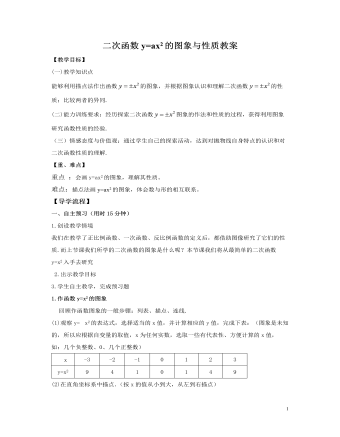
北师大初中九年级数学下册二次函数y=x2和y=-x2的图象与性质2教案
【教学目标】(一)教学知识点能够利用描点法作出函数 的图象,并根据图象认识和理解二次函数 的性质;比较两者的异同.(二)能力训练要求:经历探索二次函数 图象的作法和性质的过程,获得利用图象研究函数性质的经验.(三)情感态度与价值观:通过学生自己的探索活动,达到对抛物线自身特点的认识和对二次函数性质的理解. 【重、难点】重点 :会画y=ax2的图象,理解其性质。难点:描点法画y=ax2的图象,体会数与形的相互联系。 【导学流程】 一、自主预习(用时15分钟)1.创设教学情境我们在教学了正比例函数、一次函数、反比例函数的定义后,都借助图像研究了它们的性质.而上节课我们所学的二次函数的图象是什么呢?本节课我们将从最简单的二次函数y=x2入手去研究

北师大初中九年级数学下册二次函数y=a(x-h)2+k的图象与性质1教案
(3)设点A的坐标为(m,0),则点B的坐标为(12-m,0),点C的坐标为(12-m,-16m2+2m),点D的坐标为(m,-16m2+2m).∴“支撑架”总长AD+DC+CB=(-16m2+2m)+(12-2m)+(-16m2+2m)=-13m2+2m+12=-13(m-3)2+15.∵此二次函数的图象开口向下,∴当m=3米时,“支撑架”的总长有最大值为15米.方法总结:解决本题的关键是根据图形特点选取一个合适的参数表示它们,得出关系式后运用函数性质来解.三、板书设计二次函数y=a(x-h)2+k的图象与性质1.二次函数y=a(x-h)2+k的图象与性质2.二次函数y=a(x-h)2+k的图象与y=ax2的图象的关系3.二次函数y=a(x-h)2+k的应用要使课堂真正成为学生展示自我的舞台,还学生课堂学习的主体地位,教师要把激发学生学习热情和提高学生学习能力放在教学首位,为学生提供展示自己聪明才智的机会,使课堂真正成为学生展示自我的舞台.充分利用合作交流的形式,能使教师发现学生分析问题、解决问题的独到见解以及思维的误区,以便指导今后的教学.
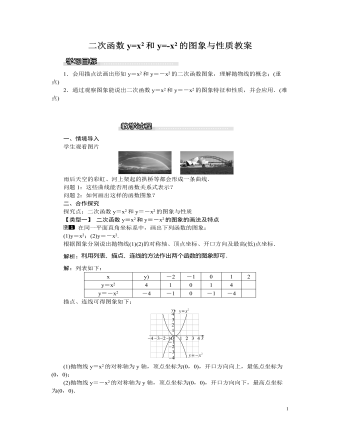
北师大初中九年级数学下册二次函数y=x2和y=-x2的图象与性质1教案
雨后天空的彩虹、河上架起的拱桥等都会形成一条曲线.问题1:这些曲线能否用函数关系式表示?问题2:如何画出这样的函数图象?二、合作探究探究点:二次函数y=x2和y=-x2的图象与性质【类型一】 二次函数y=x2和y=-x2的图象的画法及特点在同一平面直角坐标系中,画出下列函数的图象:(1)y=x2;(2)y=-x2.根据图象分别说出抛物线(1)(2)的对称轴、顶点坐标、开口方向及最高(低)点坐标.解析:利用列表、描点、连线的方法作出两个函数的图象即可.解:列表如下:x y) -2 -1 0 1 2y=x2 4 1 0 1 4 y=-x2 -4 -1 0 -1 -4 描点、连线可得图象如下:(1)抛物线y=x2的对称轴为y轴,顶点坐标为(0,0),开口方向向上,最低点坐标为(0,0);(2)抛物线y=-x2的对称轴为y轴,顶点坐标为(0,0),开口方向向下,最高点坐标为(0,0).方法总结:画抛物线y=x2和y=-x2的图象时,还可以根据它的对称性,先用描点法描出抛物线的一侧,再利用对称性画另一侧.
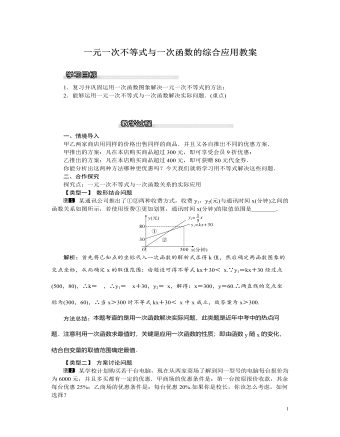
北师大初中八年级数学下册一元一次不等式与一次函数的综合应用教案
解析:(1)根据题设条件,求出等量关系,列一元一次方程即可求解;(2)根据题设中的不等关系列出相应的不等式,通过求解不等式确定最值,求最值时要注意自变量的取值范围.解:设购进A种树苗x棵,则购进B种树苗(17-x)棵,(1)根据题意得80x+60(17-x)=1220,解得x=10,所以17-x=17-10=7,答:购进A种树苗10棵,B种树苗7棵;(2)由题意得17-x172,所需费用为80x+60(17-x)=20x+1020(元),费用最省需x取最小整数9,此时17-x=17-9=8,此时所需费用为20×9+1020=1200(元).答:购买9棵A种树苗,8棵B种树苗的费用最省,此方案所需费用1200元.三、板书设计一元一次不等式与一次函数关系的实际应用分类讨论思想、数形结合思想本课时结合生活中的实例组织学生进行探索,在探索的过程中渗透分类讨论的思想方法,培养学生分析、解决问题的能力,从新课到练习都充分调动了学生的思考能力,为后面的学习打下基础.
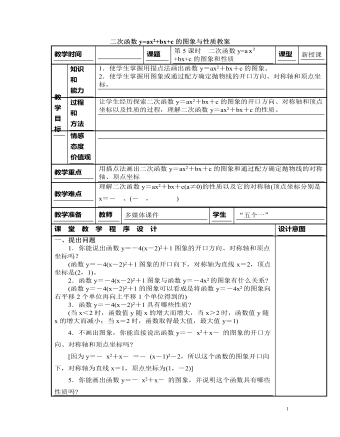
北师大初中九年级数学下册二次函数y=ax2+bx+c的图象与性质2教案
1.使学生掌握用描点法画出函数y=ax2+bx+c的图象。2.使学生掌握用图象或通过配方确定抛物线的开口方向、对称轴和顶点坐标。让学生经历探索二次函数y=ax2+bx+c的图象的开口方向、对称轴和顶点坐标以及性质的过程,理解二次函数y=ax2+bx+c的性质。用描点法画出二次函数y=ax2+bx+c的图象和通过配方确定抛物线的对称轴、顶点坐标理解二次函数y=ax2+bx+c(a≠0)的性质以及它的对称轴(顶点坐标分别是x=-b2a、(-b2a,4ac-b24a)一、提出问题1.你能说出函数y=-4(x-2)2+1图象的开口方向、对称轴和顶点坐标吗?(函数y=-4(x-2)2+1图象的开口向下,对称轴为直线x=2,顶点坐标是(2,1)。2.函数y=-4(x-2)2+1图象与函数y=-4x2的图象有什么关系?(函数y=-4(x-2)2+1的图象可以看成是将函数y=-4x2的图象向右平移2个单位再向上平移1个单位得到的)